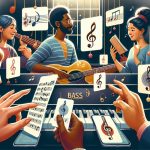When you think of iconic pop music moments, it's the catchy keyboard riffs that often jump to mind first. They're the hooks that get stuck in your head, the melodies that define a generation. From the electrifying runs of the 80s to today's chart-toppers, keyboard riffs have been the backbone of many unforgettable tunes.
These riffs do more than just sound good; they capture the essence of their time, making the songs they're part of timeless classics. Whether it's the funky grooves that make you want to dance or the soul-stirring melodies that tug at your heartstrings, there's no denying the power of a great keyboard riff in pop music. Let's dive into some of the most memorable ones that have left their mark on the music world.
The Significance of Keyboard Riffs in Pop Music
Keyboard riffs in pop music have become more than just a part of the background; they're often the soul of the song, anchoring it in the hearts of listeners. These melodies are not mere embellishments but central pillars that define the track's identity. It’s these catchy sequences that fans hum and remember, long after the song has ended.
In the realm of pop music, a great keyboard riff has the power to catapult a song from being merely good to becoming iconic. This transformation is not solely due to the melody but also how it interacts with the song's rhythm, lyrics, and overall production. A perfect example is the opening riff of "Just the Way You Are" by Billy Joel. Its simplicity and elegance immediately draw the listener in, setting the tone for the entire piece.
Historical Impact
Keyboard riffs have not only shaped single tracks but have also left a lasting impact on entire generations. They reflect the musical and cultural zeitgeist of their times. From the psychedelic 60s to the synth-heavy 80s and beyond, keyboard riffs have mirrored the evolving trends in music technology and production techniques.
- 60s and 70s: The era of experimental sounds and the rise of electronic keyboards.
- 80s: Synthesizers dominate, creating unforgettable electronic riffs.
- 90s to Present: Digital advancements lead to new sounds and the resurgence of classic vibes.
Emotional Connection
It's fascinating how a series of notes can evoke such strong emotions. A well-crafted keyboard riff can take you back in time, remind you of a special moment, or even make you feel emotions tied to a memory you didn’t know you had. The opening keys of "Clocks" by Coldplay, for example, instantly conjure a sense of urgency and nostalgia, a testament to the emotional power embedded in these melodies.
Global Influence
The influence of iconic keyboard riffs transcends geographical boundaries, making them truly global phenomena. They’re a universal language that speaks to the shared emotions and experiences of humanity. This worldwide resonance is clear when observing the global charts; no matter the country, these riffs find their way into the hearts of listeners far and wide.
- "Superstition" by Stevie Wonder
- "Jump" by Van
Evolution of Keyboard Riffs Over the Decades

Keyboard riffs have traversed a fascinating journey, evolving dramatically across the decades. From the groovy 60s to the digital era of today, they've continued to captivate audiences worldwide, leaving an indelible mark on the fabric of pop music.
In the 1960s, keyboards began to distinguish themselves in pop music, exploring new sonic territories. Classics like The Doors' "Light My Fire" introduced listeners to the potential of the keyboard as a lead instrument in a rock context. This period was dominated by the Hammond organ and the Mellotron, instruments that added depth and character to the music of the era.
The 1970s saw a surge in experimentation with electronic keyboard sounds. Progressive rock bands like Pink Floyd and Yes incorporated elaborate synthesizer solos, pushing the boundaries of what could be achieved musically. The decade also welcomed the iconic Moog synthesizer, which played a pivotal role in the development of keyboard riffing, offering a more diverse palette of sounds for artists to explore.
Entering the 1980s, the advent of digital synthesizers and MIDI technology revolutionized the music scene. This era embraced a cleaner, more polished sound, with bands like Van Halen ("Jump") and a-ha ("Take On Me") crafting some of the most memorable keyboard riffs of all time. These riffs were not just hooks but the backbone of pop anthems, driving their success across the globe.
The 1990s introduced a wave of electronic and dance music, elevating keyboard riffs to new heights. The era's technology facilitated more complex production techniques, enabling artists to layer sounds and create rich, textured compositions. Dance classics from this decade often featured catchy, repetitive keyboard sequences that became the hallmark of '90s dance music.
As the 2000s unfolded, pop music saw a resurgence of bands incorporating keyboards in innovative ways, blending electronic elements with traditional pop-rock arrangements. Coldplay's "Clocks" and Keane's "Somewhere Only We Know" are splendid examples of how keyboard riffs continued to evolve, retaining their emotive power and appeal.
Iconic 80s Keyboard Riffs that Defined an Era

The 1980s was a transformative decade for music, with the advent of digital synthesizers and keyboards shaping the soundscape of pop culture. This era saw the creation of some of the most unforgettable keyboard riffs, which not only defined the sound of the 80s but also left a lasting impact on music as a whole.
Van Halen's "Jump" is perhaps one of the most recognizable keyboard riffs of all time. The song's opening synthesizer riff, played by Eddie Van Halen, captures the energetic and optimistic spirit of the 80s. It's a synthesis of rock and pop, with the keyboard taking center stage in a way that was somewhat unprecedented for rock bands at the time.
Another hallmark of the decade was a-ha's "Take On Me." The track features a distinctive keyboard riff that complements its unique narrative and groundbreaking music video. The riff, playful yet melancholic, helped solidify the song's place in pop culture history.
The era also saw bands like Duran Duran and Depeche Mode experimenting with synthesizers to create new sounds. Duran Duran's "Hungry Like the Wolf" with its infectious synths, and Depeche Mode's "Just Can't Get Enough" with its upbeat keyboard lines, became anthems of the 80s. These bands used keyboards to craft a sound that was not only distinctive but also emblematic of the decade's flair for innovation and experimentation.
The Pet Shop Boys added to the decade's memorable riffs with their song "West End Girls." The track's introduction, a combination of low-toned keyboard riffs and spoken-word verses, set a moody, atmospheric tone that captured the essence of urban storytelling.
Here's a summary of iconic 80s keyboard riffs:
| Song | Artist | Keyboard Feature |
|---|---|---|
| Jump | Van Halen | Energetic opening riff |
| Take On Me | a-ha | Playful yet melancholic riff |
| Hungry Like the Wolf | Duran Duran | Infectious synth lines |
| Just Can't Get Enough | Depeche Mode | Upbeat keyboard lines |
| West End Girls | Pet Shop Boys |
Unforgettable Modern Pop Keyboard Riffs

While the 1980s are often hailed for their iconic keyboard riffs, the musical baton was carried into the modern era, with contemporary artists continuing to produce catchy and compelling keyboard melodies. This era's music has seen a harmonious blend of digital innovation and nostalgic influences, leading to the creation of unforgettable keyboard riffs that have quickly become the hallmark of modern pop anthems.
Artists like Coldplay and Lady Gaga have masterfully incorporated keyboard riffs into their music, creating songs that are not only chart-toppers but also musical landmarks of their time. Coldplay's "Clocks," for example, features a piano riff that is both simple and hypnotic, propelling the song into the realm of anthemic pop. Lady Gaga's "Just Dance" uses synthesizer riffs to create a dynamic and electrifying track that has become a dance floor staple worldwide.
In addition to these household names, newer artists have emerged, showcasing their ability to craft compelling keyboard-driven hits. Here are a few standout examples:
- Halsey's "Without Me" features a finely crafted synth line that underscores the song's emotional depth, making it a powerful anthem of vulnerability and resilience.
- The Chainsmokers' "Closer" leverages a catchy synth riff that not only captures the essence of the song but also contributes to its massive commercial success, clearly demonstrating the power of a great keyboard riff in the modern music industry.
Below is an overview of the impact these modern keyboard riffs have had on the charts:
| Song | Artist | Year Released | Billboard Hot 100 Peak Position |
|---|---|---|---|
| Clocks | Coldplay | 2002 | 29 |
| Just Dance | Lady Gaga | 2008 | 1 |
| Without Me | Halsey | 2018 | 1 |
| Closer | The Chainsmokers | 2016 | 1 |
These songs not only achieved commercial success but also influenced the sound of pop music, encouraging other artists to explore the potential of keyboard riffs in their compositions. The versatility and expressiveness of keyboard instruments allow for a wide range of textures and tones, making them an ideal choice for artists looking to add a distinct sound to their tracks.
Influence of Keyboard Riffs on Popular Culture

The magnetic pull of keyboard riffs in popular culture can't be overstated. They've not only cemented songs into the annals of music history but also permeated various aspects of popular culture, influencing everything from film soundtracks to personal ringtones. Artists like Van Halen with "Jump" and Europe’s "The Final Countdown" have left indelible marks, their keyboard intros instantly recognizable and often used to evoke nostalgia or excitement.
A significant impact is how these catchy melodies have become intertwined with identity and emotions. For instance, the haunting keys in Gary Jules' cover of "Mad World" have made their way into countless movies and TV shows, evoking a sense of melancholy and introspection. This demonstrates the power of keyboard riffs not just as elements of songs but as cultural touchstones that can convey complex emotions and themes.
Moreover, the visual aspect of keyboard performances in music videos and live shows has contributed to their influence on popular culture. Artists like Lady Gaga and Halsey, known for their theatricality, often incorporate elaborate keyboard setups into their performances, blending visual art with music. This not only elevates the live music experience but also sets a stylistic trend that fans and aspiring musicians look up to.
Social media and the internet play a pivotal role in the viral spread of keyboard riffs. Memes, TikTok challenges, and YouTube tutorials have introduced iconic keyboard melodies to new generations. Clips of catchy riffs are shared and reposted across platforms, sometimes even leading to a resurgence in popularity of the original songs. This digital word-of-mouth has a profound effect on how keyboard-driven songs are consumed and celebrated globally.
Lastly, the adaptability of keyboard riffs across different genres underscores their universal appeal. From rock to pop and even hip hop, a compelling keyboard riff transcends genre boundaries. The Chainsmokers' "Closer", featuring Halsey, melds electronic beats with a memorable keyboard riff, illustrating how modern pop music continues to innovate while retaining the infectious charm of classic keyboard melodies.
The influence of keyboard riffs extends far beyond the notes themselves. They shape how songs are remembered, generate new trends in music and visual performance, ignite global conversations through digital platforms, and bridge the gap between diverse musical genres. The keyboard has proven itself to be an instrument of both nostalgia and innovation, capable of continuing to push the boundaries of popular culture.
Conclusion
The power of keyboard riffs in shaping popular culture is undeniable. They're not just catchy melodies; they're the heartbeat of iconic songs that transcend time and genre. From evoking deep nostalgia to inspiring the latest internet craze, these riffs prove that the keyboard is a versatile and vital instrument in the music world. As we've seen, its influence stretches far beyond the notes themselves, touching everything from visual artistry in performances to sparking global conversations. Keyboard riffs have a unique way of bringing people together, reminding us of music's universal language and its ability to innovate while paying homage to its roots. Whether it's through a meme or a melody that moves us, the keyboard continues to play a central role in defining the soundtrack of our lives.
Harlan Kilstein began playing piano during covid with no piano background at all. He taught himself how to play learning what to do and what not to do.
Today he's an advanced intermediate player and can help you grow in your skills because he learned all this on his own.








